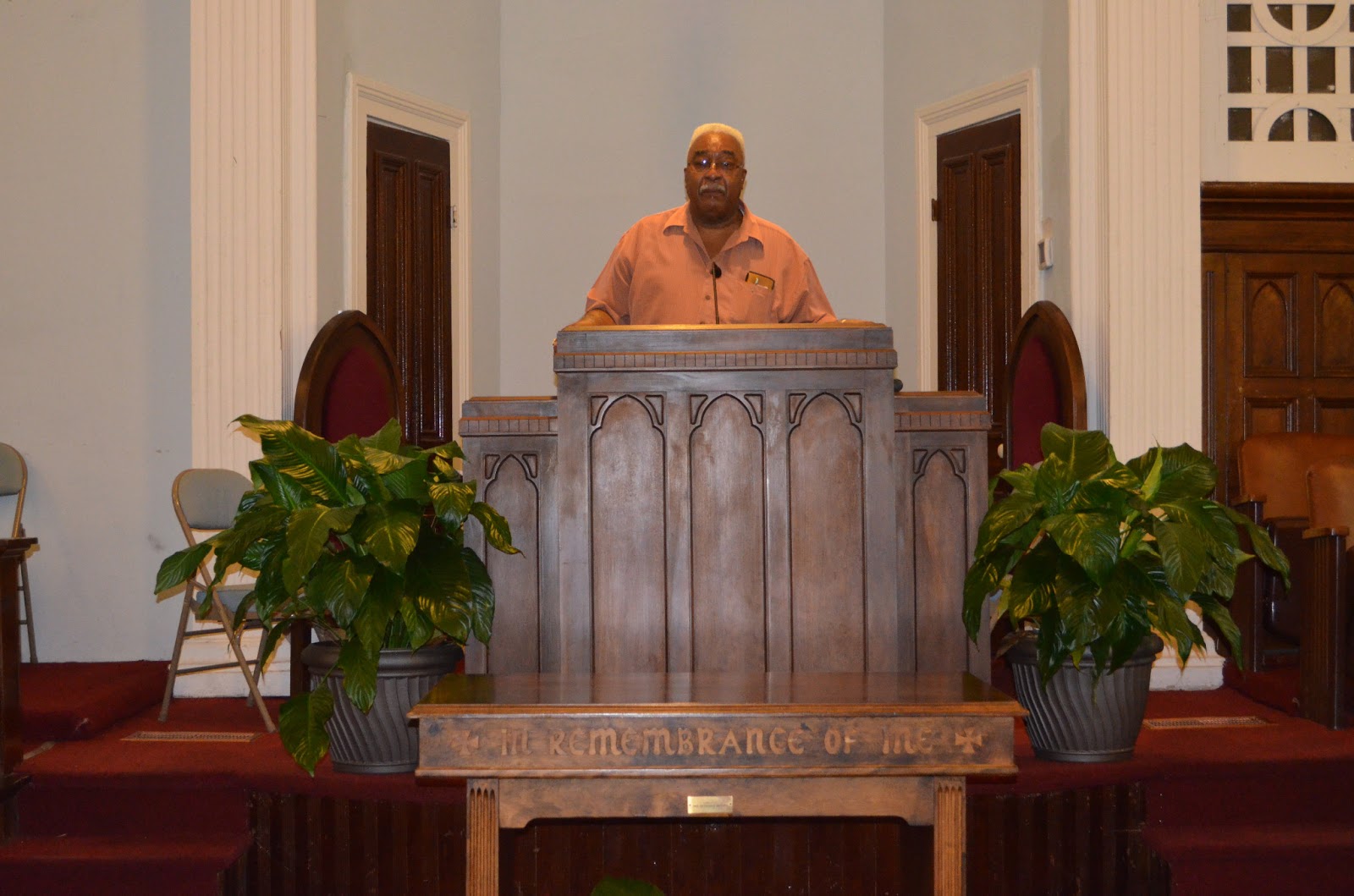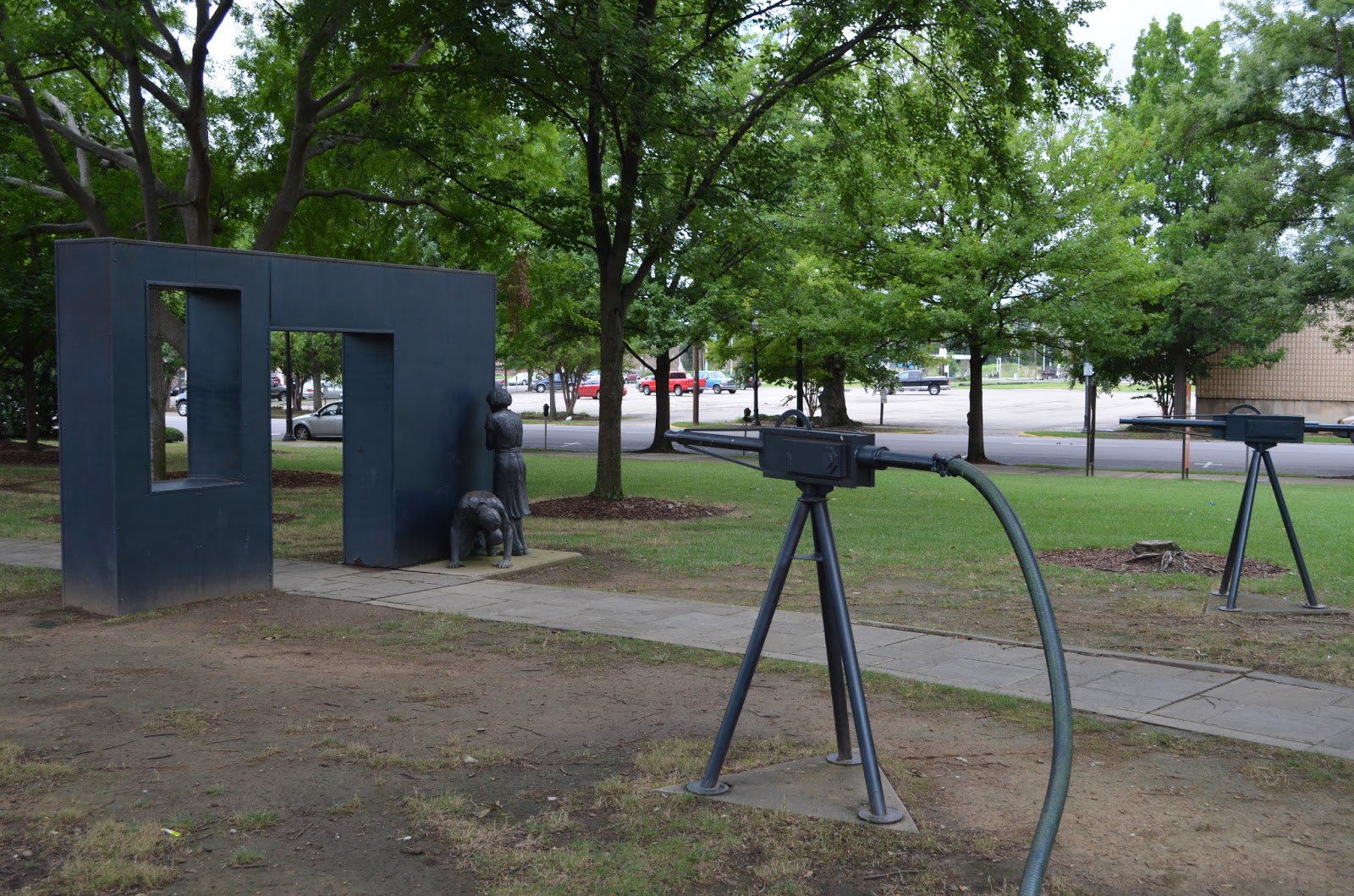Knowing what I know about African Americans and Sunday-go-to-meeting attire, I said I would not go, even though I really did want to. Despite my status as a free thinker, I LOVE gospel music and have always said that if I was to be a Christian, that'd be the way I'd go. But I felt strongly I could not disrespect the congregation and be the bearded white guy in shorts who enjoyed unreflectively the privelege to walk into a southern baptist church in a prominent African-American community wearing whatever the f*&^ he pleased.
Sarah had similar misgivings and seems to have also arrived at the same belief about "if I were a Christian I'd go Baptist for the music and singing and participation!" But Kathie spiffed her up in silky black pajama pants that Sarah was uncomfortable with, but looked just fine with a clean simple top. Kathie looked presentable too, so the three of them went to go inside at about 11am Sunday.
I sat mulling the situation over on a wall across the street, watching church-goers walk up in twos and threes dressed, as I knew they would be, to the "nines" for the service. As regretful as I was, I thought I was doing the right thing. A white guy in shorts pulled up in a car with Kansas plates, and ran up and in late, and I said to myself, "that's the guy I don't want to be."
Still, Kathie was texting me saying she'd located an inconspicuous spot in the balcony and urged me to get in there. I could hear the Hammond organ, drums, various instruments and a big choir going. Ambivalent, I relented against my stance of principle and snuck up the balcony to where they were.
 Well the service was all I could have asked for - lively and incredibly talented gospel singing and harmonies, a kickin' organ (I'm a sucker for that alone), and an engaged congregation. I missed the baptisms which were reportedly also very exciting, but the rest of the service was uplifting even for someone who has some contrarian views about god and religion. In fact, I took this pic elsewhere during our trip to note how striking it was to find a fellow traveler.
Well the service was all I could have asked for - lively and incredibly talented gospel singing and harmonies, a kickin' organ (I'm a sucker for that alone), and an engaged congregation. I missed the baptisms which were reportedly also very exciting, but the rest of the service was uplifting even for someone who has some contrarian views about god and religion. In fact, I took this pic elsewhere during our trip to note how striking it was to find a fellow traveler.Pastor Price did a very good job with the sermon, based on the theme "Turn in Your Title, Take a Towel," focusing on a bible segment about Jesus washing his disciples' feet at the Last Supper. Important lessons he imparted about the significance of setting aside one's preoccupations with status to become a real, true leader.
Here I need to digress into something sticky. In all the work I do as a social justice educator and in all the workshops on identity, race and class I've participated in, the thing that sticks with me most as a lesson I carry with me every day is this. We never eliminate or dispose of our biases, at best we can identify and acknowledge them, anticipate their emergence or reconsider whether and how they may shape our thoughts, feelings, actions, words. If we work hard at it, we can get good at checking them before they express themselves in ways we might not intend and do damage. I think Brenda Allen at Smith helped me understand this best by telling me we all carry them with us, it's what we do about that that matters.
So in that spirit, I shared my initial reactions to Pastor Price with Sarah which were really quite different than what I write here. In hindsight now I think I need to explain all this to her too. My first reaction to the sermon was that I found it to be more theatrical than substantive, and perhaps in my own mind also, my only role model for such sermons is MLK himself who, to be fair, is very likely in a class of his own. I think I reacted this way too to several of the docents we encountered at civil rights museums. That their use of hyperbole, their employment of a preaching style, or in particular, the part of it that is about gaining momentum and pace, exploiting and enhancing verbal impact through rhyme, repitition, alliteration - other *techniques* - somehow raises suspicion in me. Suspicion that the medium and delivery have become more important than the message. That the deliverer's obvious self-pleasure at their own delivery as performance is about themselves somehow and not about the content which they are trying to address. Or, maybe about attempting to manipulate the audience through technique rather than content. And that somehow this style (which, by the way, one might readily identify in other modes like hip-hop!) sets off my BS detector. It makes me listen harder and ask: are those mechanisms of delivery really enhancing the message? Or are they cheap efforts at distracting me from some lack of depth or insight or sophistication? Is there depth and meaning in there, or are the techniques somehow shortcuts to impact, like a sugar buzz? I might say this is a reaction to a sales pitch anyone might reasonably have, but as I check myself here I wonder: is this a reaction based on a latent cultural bias? Is it a coincidence the same things that put my neck hairs on end come from preaching and hip-hop? I remember arriving to Cape Town to meet up with my colleague Louis Wilson, Afro-Am Studies Professor for our South Africa program. We both flew Delta and both flights showed "Remember the Titans." He asked me what I thought and I told him I thought it was sappy and "Hollywood." He looked hurt and said he'd found it inspiring. I chalked this off to our generational difference. But... So overall, as I now reconsider all this and try to remember those lessons I said I've taken from this work, I am now asking whether I'm not only being hypercritical and unfair, but in fact missing some of the spirit and intent of such delivery when I evade soaking in the medium and its musicality, its art, its cultural expression... I now think perhaps Pastor Price worked pretty hard on the whole package and that bringing it all together like that is not only some work, but artful.
Amidst the sermon though, this atheist couldn't help but find funny several remarks he made - clearly to be understood in part through the lens I describe above but also just simply because they're funny on their own.
1. "Jesus can change your paycheck". Really? Gotta look into that.
2. "By and by, there are gonna be some stinky feet in the relationship." The context is important here and it was meant to be humorous, but the idea followed from the concept that marriage follows the wedding...
3. "At Jesus' dry cleaners, the detergent he uses us not Tide, not All, it's his word." I found myself wondering things like "does he use starch?" and "does he pick up and deliver?" and "what's his view on toxic chemicals..."
But "Trade in your title; take a towel" was delivered with style, and I'm glad I got to witness it.
Of course, my plans to be entirely inconspicuous ended when the Pastor asked all guests to stand up and be welcomed. I felt genuinely welcomed, and also entirely confirmed in my ambivalence about being the white guy in shorts after all.

































